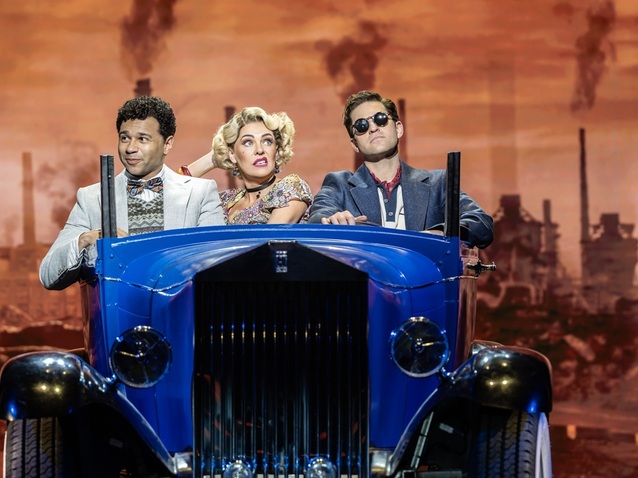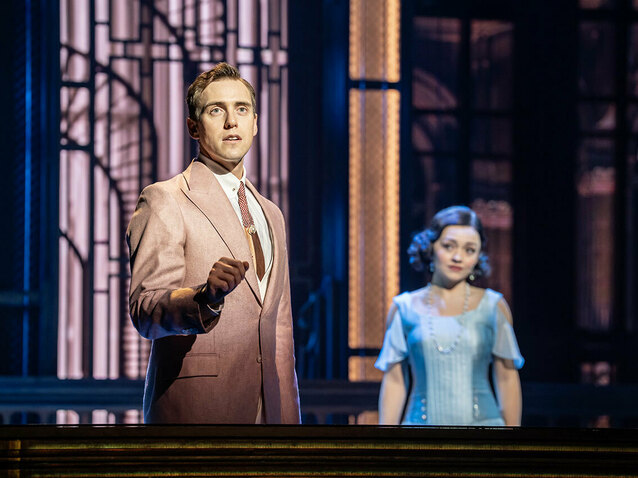 © Johan Persson
© Johan Persson
It is exactly one hundred years since F. Scott Fitzgerald’s The Great Gatsby was published in 1925. It received generally positive reviews, but some critics felt it compared unfavourably with his previous novels This Side of Paradise (1920) and The Beautiful and Damned (1922), and it was not a great commercial success. In fact, when Fitzgerald died in 1940 he believed himself to be a failure and that his work would soon be forgotten. However, during World War II the Council on Books in Wartime distributed free copies to American soldiers serving overseas. This saw a surge in its popularity and a scholarly reexamination, leading to the book being placed on most American high school curricula.
The novel presents quite a scathing critique of the so called ‘American Dream’. Set in 1922, with the Jazz Age that followed World War One being equated with hedonism, it sees bond salesman Nick Carraway become involved with multimillionaire Jay Gatsby when he rents a small house in the Long Island village of West Egg next to Gatsby’s huge estate. It transpires that Gatsby met Nick’s cousin Daisy in 1917 when he was an officer in the American Expeditionary Forces, and that they fell in love. When Gatsby was deployed overseas, however, Daisy ended up marrying the brutish but wealthy Tom Buchanan. Ever since returning from the War, Gatsby has devoted himself to becoming rich (by bootlegging alcohol during the prohibition era) in an effort to win Daisy back, because ‘rich girls don’t marry poor boys’. He hosts extravagant soirées, which everyone attends yet he hardly graces, in the hope of attracting her as a guest, and enlists Nick’s help to engineer a meeting.
When Gatsby and Daisy’s love is rekindled, he believes the dream he has worked so hard to fulfil will be realised and that she will leave Tom, but he is thwarted by several things. These include Daisy’s own shallowness, and a society that judges him as representing sordid ‘new money’ as opposed to noble ‘old money’. As the situation plays out, the actions of Tom and Daisy in particular have disastrous consequences for several other people including Gatsby himself, while they walk away unscathed.

Corbin Bleu, Rachel Tucker & Jon Robyns in The Great Gatsby West End (c) Johan Persson
There have been several films based on the novel, but this new musical version, with music by Jason Howland, lyrics by Nathan Tysen and book by Kait Kerrigan, came to Broadway in 2024 and is now appearing at the London Coliseum. It does a good job of adjusting the novel to make it fit for the stage, and in the process there are some possibly serendipitous results. The book is told in the first person by Nick, and the musical acknowledges this by beginning and ending the evening with the focus on him. For example, the show starts with him declaring the novel’s first line before singing the song ‘Roaring On’, in which he describes the set-up. In between these points, however, the story is not told entirely from his perspective, so that Gatsby is given his own voice far more since we do not see the character solely through Nick’s eyes. The novel has many iconic lines that feel like snappy soundbites, and so their inclusion in the libretto works well. The musical also succeeds in rolling all of the book’s plot points and themes into the various scenes and songs so that it covers everything it needs to, while adopting a pace that feels suitable for the medium.
There are a few changes in emphasis, with the dynamic in the relationship between Nick and the golfer Jordan Baker feeling quite different, presumably as a way of aiding the drama. Nick declaring that he is engaged to Jordan at the moment at which in the novel he simply remembers it is his birthday certainly feels more impactful on a stage. Tom’s mistress Myrtle Wilson also makes a very different decision in the musical, which overall makes her a more sympathetic character for whom we consequently feel more deeply. Given this, however, the fate she suffers does not quite hit the mark because the explanation that now has to account for it rests to a greater extent on chance timings.
The general setting, and Gatsby’s soirées in particular, provide plenty of opportunities for exuberant routines to be presented, and choreographer Dominique Kelley sees the Charleston rub shoulders with tap dancing as everyone dons chic or glitzy costumes, courtesy of Linda Cho. The score certainly contains many allusions to the popular music of the 1920s, but it does not simply present a pastiche of the Jazz Age style. For example, the music for a party in a New York hotel room seems more modern, but in feeling quite psychedelic it conveys the hedonistic spirit of the original setting. The song ‘Shady’, sung by the character of Meyer Wolfsheim, reveals the underhand dealings that underpin the entire affair, but the musical is especially effective at creating moments of ‘purity’ amidst all the ‘sordidness’. If, however, these seem to stand apart from everything that surrounds them in one respect, they still feel weighed down by the corrupt world in another, so that it is hard not to see some characters as fickle, even when their proclamations appear so sincere.

Jamie Muscato & Frances Mayli McCann in The Great Gatsby West End (c) Johan Persson
The real coup of director Marc Bruni’s production is the stage design, with scene changes being rendered beautifully by walls and props sliding smoothly into place. Many scenes feature Art Deco metalwork that feels enchanting and captures the spirit of the age, while Cory Pattak’s lighting effects also aid the atmosphere. There is a neatness and ‘straightness’ to these sets that highlights the stark contrast between the rich, elegant world they portray and the poor, depressed area where the character George Wilson has his garage. Metal still appears in this ‘valley of ashes’, but now in the form of a bridge overhead and the support to the poster bearing the eyes of oculist Doctor T. J. Eckleburg. The lines that are created in this instance stand at disconcerting angles, thus contributing to the image of a ‘dystopian’ hell.
The staging is particularly effective at portraying movement so that a car driving into New York advances a little while computer generated scenery, courtesy of scenic and projection designer Paul Tate DePoo III, drops away behind it at a faster rate. The impression created when the car crosses a bridge going into Manhattan is especially strong as the wrought iron girders pass quickly over the top of it. Other persuasive settings include Tom and Daisy’s garden, with its strong sense of perspective as the hedges flow back to the house in the distance, and Nick’s quaint home with its lush foliage.
Chris Ma conducts the eighteen strong orchestra well, while there are excellent performances from Corbin Bleu as Nick, Frances Mayli McCann as Daisy, Jon Robyns as Tom, Amber Davies as Jordan, Joel Montague as George, Rachel Tucker as Myrtle and John Owen-Jones as Meyer Wolfsheim. The standout performance, however, comes from Jamie Muscato who has exactly the right persona for the enigmatic character of Jay Gatsby, and whose voice is extremely smooth, accomplished and impassioned.
By Sam Smith
The Great Gatsby | 24 April - 7 September 2025 | London Coliseum
the 25 of April, 2025 | Print
Comments